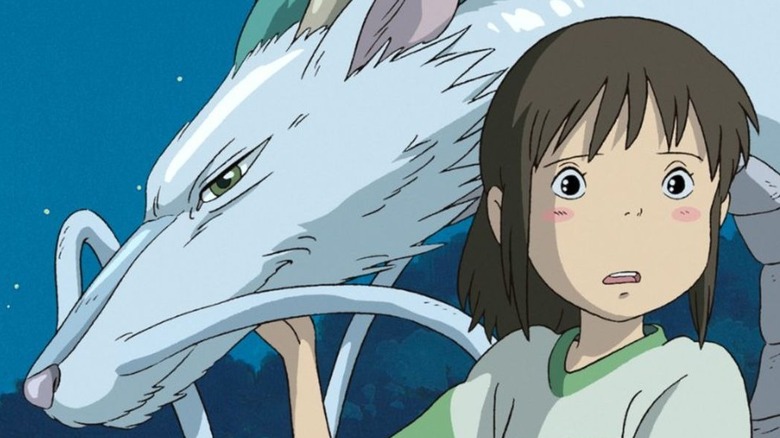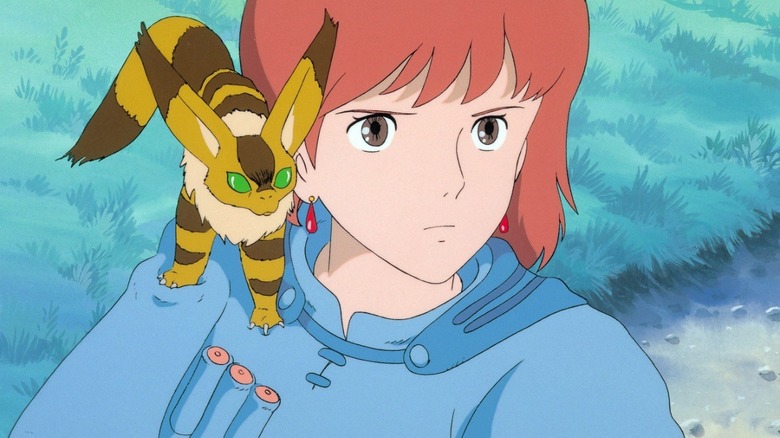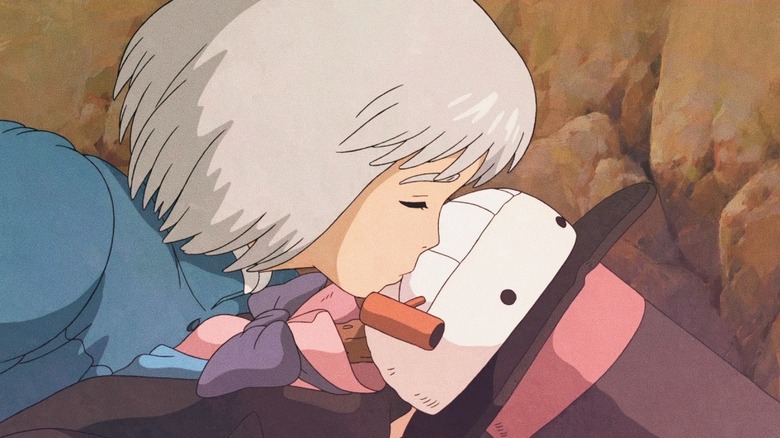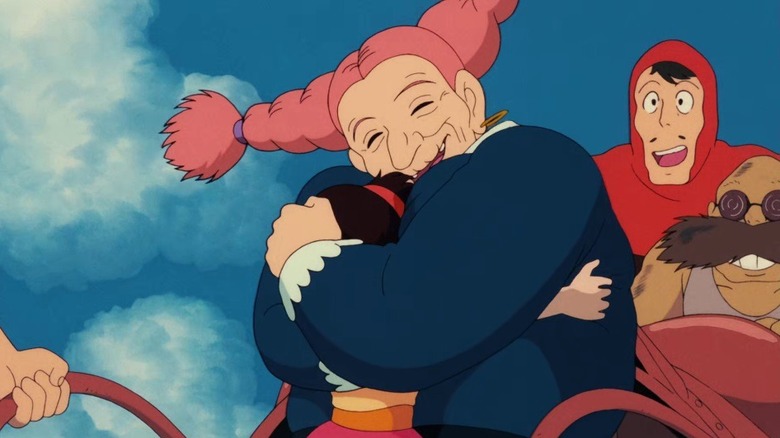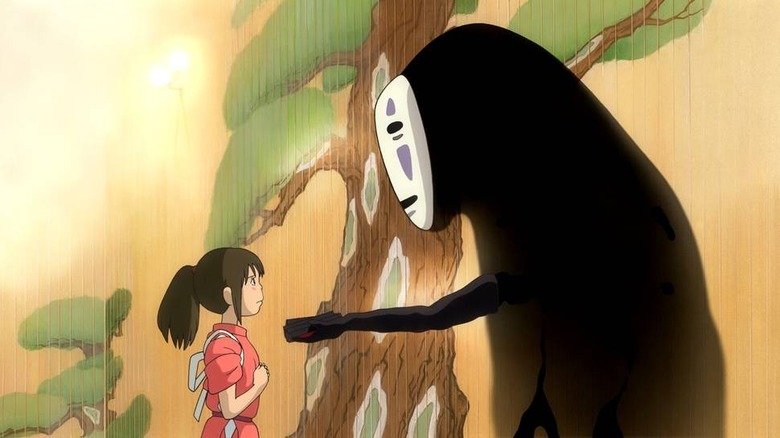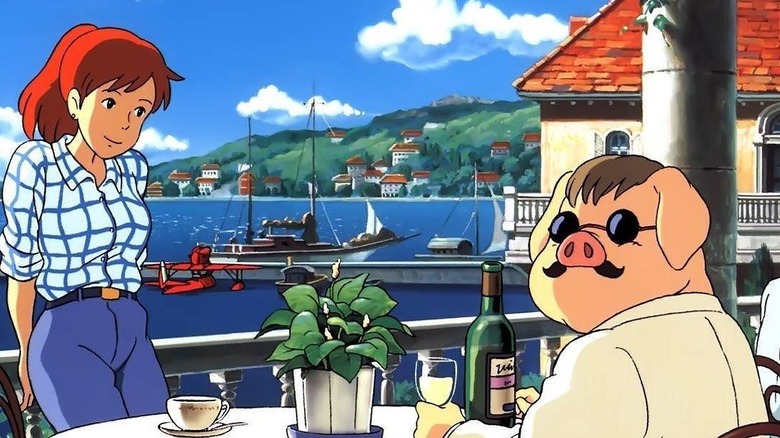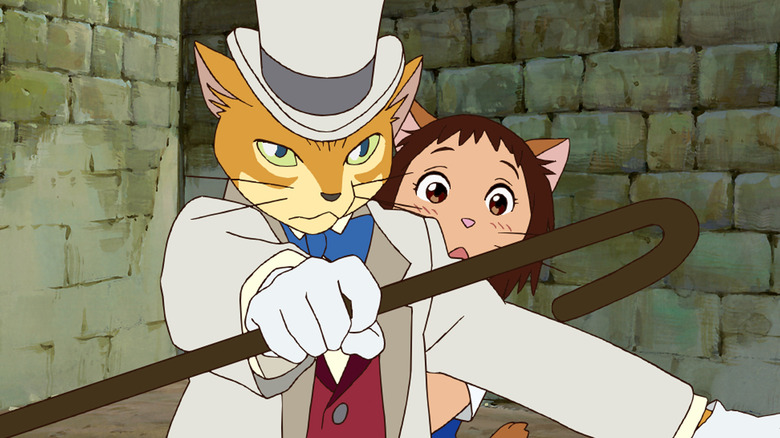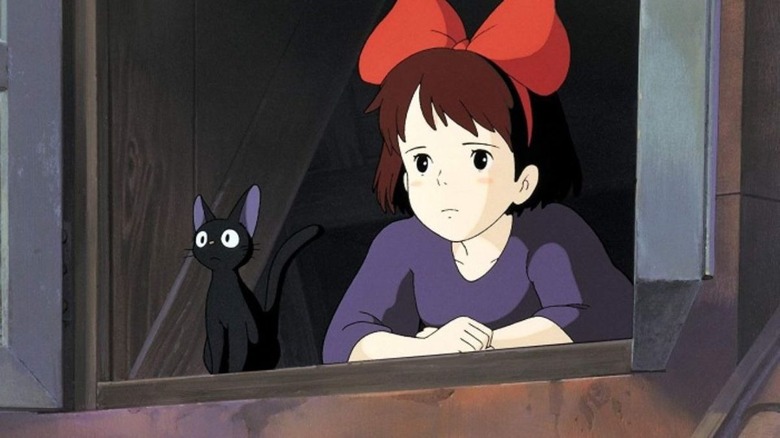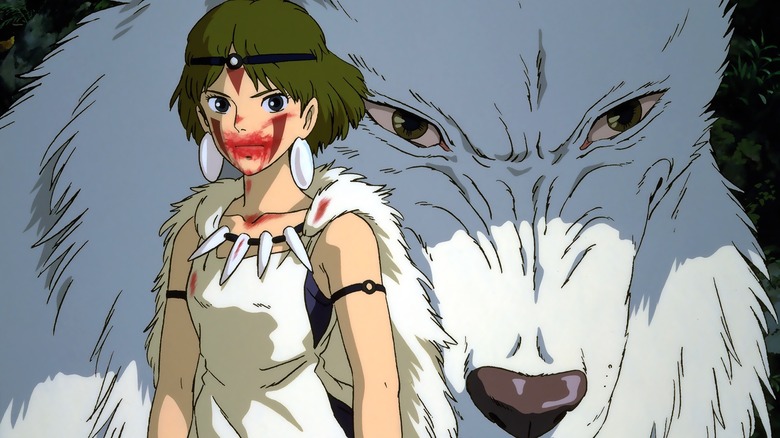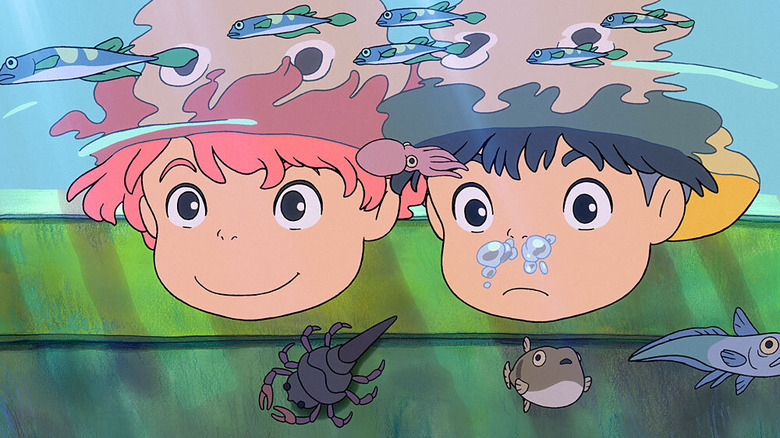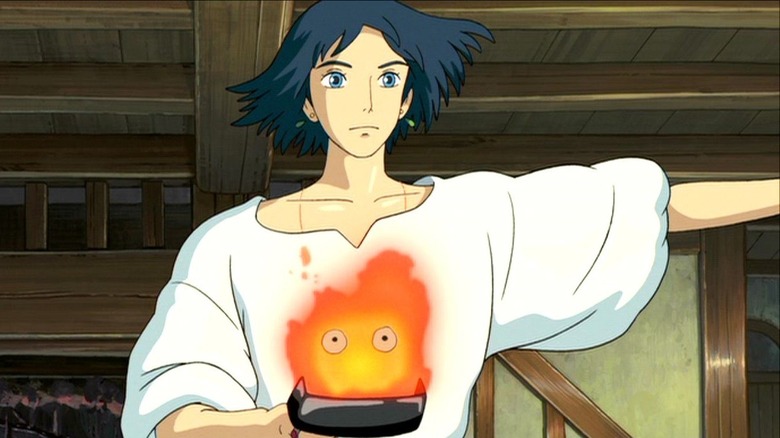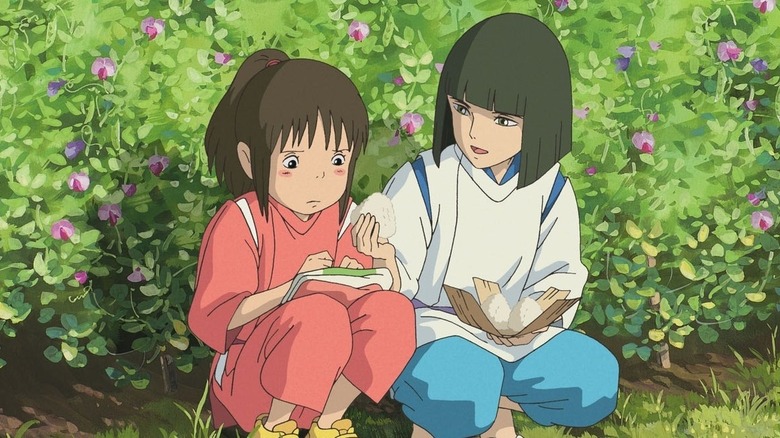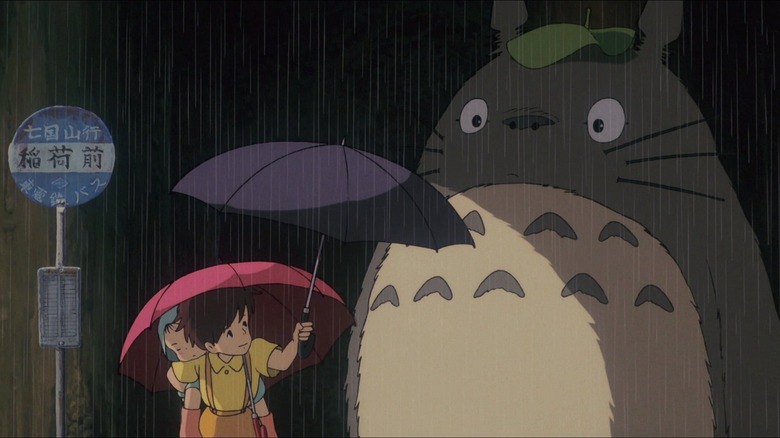Studio Ghibli Companions Ranked Worst To Best
Studio Ghibli has become well known for producing layered, likable protagonists that eschew stereotypes, yet it's often the supporting players that steal the limelight in the powerhouse studio's films. Studio Ghibli co-founder Hayao Miyazaki has always taken great pride in the fact that his movies routinely feature "strong female leads" who aren't looking for a "savior," but these young heroines still "need a friend or a supporter" in their corner, as he told The Guardian in 2017 (via Vice). Creating these companion characters is where Miyazaki and his colleagues at the famous studio really shine, though some of them have managed to live longer in our collective memory than others.
From the film that got the studio going to the Miyazaki masterpieces that made it famous the world over, we've gone back over Ghibli's glittering catalog of movies and handpicked its most notable companions ever. Ranked from worst to best, here they are.
Teto from Nausicaä of the Valley of the Wind
Over a decade before Ash Ketchum began running around with Pikachu on his shoulder, Nausicaä and her furry yellow companion Teto were doing the same thing. What makes Hayao Miyazaki's '80s classic "Nausicaä of the Valley of the Wind" vastly different from "Pokemon" is that the protagonist isn't trying to catch the weird and wonderful creatures that inhabit her world, she's trying to make peace with them.
The film, which led to the creation of Studio Ghibli and was subsequently included in box set releases, takes place in a post-apocalyptic far future. Humankind's use of bioweaponry has left much of the earth covered in a toxic jungle, and the mutant insects that dwell inside it are frightening to behold. Nausicaä (princess of the titular valley) isn't afraid of them, however — she frequently explores the vast jungles, studying and interacting with the inhabitants.
When Nausicaä learns that her military-minded neighbors in Tolmekia plan on burning the jungle down, she and Teto leap into action. The princess receives the feisty little fox squirrel as a gift early in the film, and it's not exactly love at first sight. The terrified creature sinks his teeth into her finger during their first meeting, but when she doesn't react, Teto realizes there's nothing to fear and proceeds to lick the wound he just created. They're fierce friends from that moment onwards, rarely leaving each other's side.
Turnip Head from Howl's Moving Castle
Loosely based on the Diana Wynne Jones book of the same name, 2004's "Howl's Moving Castle" is an anti-war film about a cursed girl who meets a troubled young wizard. We follow a milliner named Sophie, who gets turned into an old woman by a vindictive witch. She sets out to reverse the curse, but with her youth gone and military conflict looming, it won't be easy. Luckily, she picks up a bunch of companions along the way, one of whom is there for her more than any other.
When Sophie enters the wastelands looking for the witch that cursed her, she comes across a stranded scarecrow that she dubs Turnip Head. He's incredibly grateful when Sophie frees him from a bush he's stuck in, fetching her a walking stick and locating a place for her to stay. He leads her to Howl's castle and later saves her life when the mobile fortress begins to crumble, steering a breakaway room down a cliff edge and snapping his pole in the process.
It's after he's saved Sophie and her friends that we learn the truth about Turnip Head — she plants a kiss on him, and he transforms into an immaculately dressed blonde prince. It turns out he was also under a curse, and now that it's broken, he's going to do everything in his power to stop the war.
Dola from Laputa: Castle in the Sky
The first film released under the Studio Ghibli banner, 1986's "Laputa: Castle in the Sky" has all the charm and wonder of the studio's later outings, but it doesn't offer much in the way of cute creatures. In fact, the main companion character in "Laputa: Castle in the Sky" couldn't be further away from that. Dola (brilliantly voiced by Cloris Leachman in the dub) is an elderly but highly formidable woman who leads a gang of air pirates, three of whom are her own sons. She and her boys are on the hunt for the fabled floating city of Laputa, said to contain untold treasures.
We enter the story when Sheeta, a royal orphan who holds the key to unlocking Laputa, is captured by dastardly government agent Colonel Muska, who also seeks the treasure. She falls from the sky when Dola's gang attack, but the crystal around her neck (passed down from her Laputan ancestors) activates and slows her descent into the mining town below. Sheeta is taken in by a local boy named Pazu, and the pair set out to find Laputa together.
Along the way, Dola goes from an enemy to a badass grandma-type figure. Despite her tough exterior, she develops a soft spot for the two kids, and ends up helping them rather than hindering them. Her catchphrase might be "One for all and all for mom," but there's a big heart under all that bravado.
No-Face from Spirited Away
Hayao Miyazaki's Oscar-winning classic "Spirited Away" is another Studio Ghibli film jam-packed with wonderful supporting characters, the most iconic of which is arguably No-Face. This creepy-looking spirit takes a shine to protagonist Chihiro, who becomes trapped in another world when her parents stop at what they believe to be an abandoned theme park. She discovers too late that it's dangerous to be there after dark — when the sun goes down, her parents are transformed into pigs and the previously dry river they crossed is suddenly in full flow.
Chihiro has no choice but to find work at a bathhouse for spirits, which is where she encounters No-Face. The spirit (commonly referred to as a "he," though the character's gender isn't explicitly stated) takes an immediate interest in her. She later invites the lurking spirit in through a side door, and the word grateful would be an understatement. No-Face develops an obsession with Chihiro, who is now going by "Sen" having given up her real name as part of her contract with the witch Yubaba, boss of the bathhouse.
No-Face goes on a pretty terrifying rampage at one stage, but the lonely spirit tags along with Chihiro after throwing up the staff members consumed during the commotion. The iconic character ends up becoming the companion of Zeniba (Yubaba's equally powerful and far-friendlier twin sister), who teaches the spirit how to knit.
Fio Piccolo from Porco Rosso
"Porco Rosso" is Hayao Miyazaki's love letter to Italy, a place that has inspired him on numerous occasions. According to the Italian website Daily Best, the filmmaker visited the Mediterranean country in 1990, two years before "Porco Rosso" was released. He captures the dazzling beauty of the Adriatic Sea masterfully — though, like many Miyazaki films, the depiction is juxtaposed with a political undercurrent.
Set in the 1930s with fascism on the rise in Italy, "Porco Rosso" — a loose translation of the original Japanese title "Kurenai no Buta," meaning "Crimson Pig" — follows a World War I fighter pilot-turned-bounty hunter living with a curious curse. Porco transformed into an anthropomorphic pig at some stage, though Miyazaki doesn't explain the hows and the whys of his predicament. When the character himself is asked about it, he simply says that "all middle-aged men are pigs," indicating that he's accepted his fate. It's not until Fio Piccolo enters his life that Porco's self-loathing begins to subside.
After his plane is shot down by a rival, Porco visits his favorite engineer in Milan. All his sons are busy, however, so Porco has to make do with his daughter, Fio. The initially skeptical bounty hunter is so impressed with Fio's work that he lets her accompany him back to the coast, where she helps Porco overcome his rival and his curse, if only for a moment — Fio catches a glimpse of his real face towards the end of the movie.
The Baron from Whisper of the Heart and The Cat Returns
Baron Humbert von Gikkingen (popularly known as The Baron) made his debut in the coming-of-age classic "Whisper of the Heart," directed by the late Yoshifumi Kondo. He's a character in a story penned by the film's 14-year-old protagonist Shizuku Tsukishima, who becomes inspired by a cat statue she comes across in a Tokyo antique store. Shizuku dreams up a tale in which The Baron comes to life and goes in search of his lost love, and she writes herself into the story as the main character.
The Baron played companion to a second schoolgirl in the 2002 spin-off "The Cat Returns," another lesser-seen Studio Ghibli gem. The film follows timid teen Haru Yoshioka, who hides her amazing ability to communicate with cats. She ends up being whisked away to a place called the Cat Kingdom after saving a royal cat from getting run over at a crossing one day, and soon finds that she can't leave. That's where The Baron comes in.
The statue that inspired Shizuku to put pen to paper in "Whisper of the Heart" comes to life to help Haru in "The Cat Returns," entering the Cat Kingdom through a secret entranceway and coordinating a rescue effort. Both films are considered to be among the best anime movies ever made, and The Baron is at the heart of each of them.
Jiji from Kiki's Delivery Service
Witches don't cackle over bubbling cauldrons in Hayao Miyazaki's film "Kiki's Delivery Service;" they use their powers for good, instead. We enter Kiki's story when, as per witch tradition, she's preparing to leave home at the age of 13. She goes in search of a place where a witch could be of some use and settles on the city of Koriko (inspired by a trip Miyazaki took to Sweden, Studio Ghibli producer Toshio Suzuki told First Showing in 2008), where she does deliveries for a small bakery. She doesn't go alone, however.
While "Kiki's Delivery Service" paints a different picture of witches, Kiki still flies around on a broom (how else is she going to deliver those baked goods all over the city on time?), and she has a black cat, Jiji, as her companion. The kind of companion Jiji is depends entirely on which version of the film you watch. In the original Japanese version, Jiji is voiced by female actor Rei Sakuma and is depicted as a professional and respectful character, backing Kiki up with no questions asked. In the Disney dub, Kiki's cat companion is voiced by Phil Hartman and adds far more humor to proceedings. The veteran actor (who voiced multiple characters on "The Simpsons") plays the part with a comical reluctance, keeping Jiji's loyalty but turning the cat into a pessimist.
The English dub is dedicated to Hartman, who died before it was released.
Moro from Princess Mononoke
1997's "Princess Mononoke" was the first film to be dubbed by Disney following a distribution deal between the American giant and Studio Ghibli, though the Mouse House had no idea what to do with it. It was far too violent to be released under the Disney banner (we're talking decapitations), so it was passed off to Harvey Weinstein, head of Miramax at the time. The now-disgraced producer clashed with director Hayao Miyazaki over the latter's strict no-edits policy during a meeting in New York, it was later revealed. "I defeated him," Miyazaki told The Guardian in 2005. Weinstein was reportedly livid, but the film was released with no cuts in the States, and with a talented voice cast to bring it to life.
It's the story of a fatally-cursed prince (Ashitaka) and a wolf-raised, human-hating girl (San) who get caught up in a war between ancient forest spirits and the people encroaching on their sacred land. San appeared on the film's promotional material along with her companion, the wolf goddess Moro, in what is now an iconic Ghibli image. They make a memorable pair, terrorizing the men cutting down the forest to feed their ever-growing settlement, Iron Town. Claire Danes voices San in the English dub, while Gillian Anderson (who was a fan of Miyazaki before working on the film) brings her soothing tones to Moro.
Brunhilde from Ponyo
Inspired partly by Disney's "The Little Mermaid" according to Studio Ghibli producer Toshio Suzuki (via First Showing), Hayao Miyazaki's "Ponyo" is the story of a little boy who makes a magical friend by the sea. When five-year-old Sosuke notices goldfish Brunhilde trapped inside a glass jar, he promptly smashes it to save her, cutting his finger in the process. He quickly realizes that this is no ordinary goldfish — Brunhilde licks his wound and it heals instantly.
Brunhilde is the daughter of a submarine-dwelling wizard and a sea goddess, though Sosuke doesn't know that. He names his new pal Ponyo and promises to protect her, but he's no match for her old man. Brunhilde's worried dad uses his magic to bring her back to the ocean, setting in motion a chain of events that will cause trouble on land. It turns out Ponyo (as she now wishes to be known) has some impressive powers of her own, and she won't be torn away from Sosuke that easily. The insatiable goldfish uses her magic to escape her father's submarine and transform herself into a little girl. She's taken in by Sosuke's mother when she shows up at his house, where they wait out the coming storm that her epic transformation triggered.
Ponyo is voiced by a young Noah Cyrus in the English dub, while Frankie Jonas plays the part of Sosuke. Sosuke's mother, Lisa, is brought to life by Tina Fey.
Calcifer from Howl's Moving Castle
Turnip Head is Sophie's loyal ally in "Howl's Moving Castle," but he's not the only memorable companion character in this Oscar nominated film. The eponymous wizard also has a close friend that he relies on, in more ways than one. Calcifer keeps Howl's castle moving, a fire demon who lives in the structure's hearth. He's voiced by Billy Crystal, and his performance is largely what makes the English version of "Howl's Moving Castle" the best Studio Ghibli dub to date. Crystal brings his particular brand of sarcasm to the role, making Califer a constant source of comic relief. He's bound to Howl (Christian Bale) by a magical contract that he's always trying to break, but it soon becomes clear that he cares about his master more than he likes to let on.
Califcer becomes a big part of the makeshift family that forms over the course of the movie, which ultimately influenced his appearance. "I first planned on making him look more vibrant and flashy, but then we decided his image had to be congruent with the family-like atmosphere later on in the film, so we went back and toned down a little," the feature's director of digital imaging, Atsushi Okui, said in "The Art of Howl's Moving Castle" (via Fandom). "The dazzling features of his first appearance are left intact for impact, but I gradually began to grasp Calcifer's personality later on."
Haku from Spirited Away
Ten-year-old protagonist Chihiro receives help from a host of different characters in Hayao Miyazaki's "Spirited Away," but she forms a special bond with one in particular. In fact, Chihiro and Haku already had a bond when she stumbled across the bathhouse for spirits, they just didn't know it.
Haku is the first spirit character that Chihiro encounters in the film, and, while his motives seem unclear at times, he's revealed to be her most loyal companion. It's Haku who warns Chihiro to get back across the river before nightfall when she unwittingly crosses into the spirit realm — and when she isn't able to do that, he provides her with food from his world (preventing her from vanishing) and helps her get a job at the bathhouse.
He knows that antagonist Yubaba took an oath to give work to anyone who asks because he's her number one henchman, a fact that initially disturbs Chihiro. She soons discovers that he's just another victim of Yubaba, however. Like Chihiro (who goes by the name Sen during her time at the bathhouse), Haku had to give up his real name when he entered Yubaba's service. This is how she controls them, but what the witch failed to realize is that Chihiro and Haku had met before — it turns out he's a river spirit who once carried Chihiro to safety after she fell into his waters. This revelation breaks Yubaba's hold over Haku.
Totoro from My Neighbor Totoro
The most famous of all the Studio Ghibli companion characters (and for good reason), Totoro is the name of the forest spirit that sisters Mei and Satsuki (voiced by Elle and Dakota Fanning in the English dub) come to rely on in "My Neighbor Totoro." The girls have just moved to the countryside with their father in order to be closer to the hospital that's looking after their ailing mother, and there's not much going on around the old, traditional house. That is, until younger sibling Mei discovers the titular spirit taking a nap in the nearby woodlands.
Totoro appears before Satsuki as the sisters wait for their father at the local bus stop, wearing a leaf on his head to keep him dry in the rain. She offers the spirit her dad's umbrella, and he gives her some acorns in return. Later, when Mei goes missing trying to walk to the hospital alone, Totoro comes to the rescue. As the grown-ups organize a search party, Satsuki goes to their new friend for help and he pulls in a favor from Catbus (a giant cat-bus hybrid that's equal parts cute and creepy), who races across the countryside and locates Mei before any harm comes to her.
Totoro is also featured in the little-known short sequel "Mei and the Kittenbus," which can only be seen at the Studio Ghibli museum.
